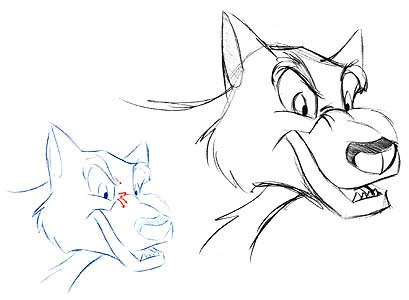Christopher Hart continues his series of six tips on how to bring animated characters to life.
My book, How to Draw Animation, has found its way into many animation classrooms. So I was delighted when the people at Animation World, a Website I frequent, asked me if they could reproduce some of the art from the book. My aim in creating the book was to marry art instruction with appealing characters. Appealing characters lie at the heart of animation; and it always struck me that unless you create great characters, it's pointless to put so much energy into making them move. If you are interested in learning more about character design (both cartoony and semi-realistic types), as well as in creating fluid, convincing motion based on fundamentals and more advanced techniques, then give these pages a look. Although the examples given are of 2D animation, the same principles may carry over to 3D.
Last month we covered "Pushing an Expression," this month we continue with how to add the correct facial wrinkles to these exaggerated expressions.

Getting Facial Wrinkles Right
Wrinkles in the face are caused by the regular flexing of facial muscles. When people make expressions, they're flexing their facial muscles. Think of expressions as muscles thrusting in a direction, and think of the wrinkles as the reaction to those forces.

replace_caption_hart01-1.jpg
When the mouth widens into a smile, it pushes the crease lines around the cheeks out, the same way this finger stretches this line. The points where the force of the mouth meets the cheek will show the most reaction.

The face has many muscles. A down-turned mouth is caused by the muscles below the lower lip and in the chin.
Line Flow
Instead of accurately portraying the crease lines from the nose to the mouth, and then drawing a separate set of crease lines from the lips to the chin, it's more pleasing to simplify everything. Just join the creases to form one long line from the nose down to the chin.


(Accurate version.) (Simplified version.)
Snarl Wrinkles
The snarl wrinkle travels from under the eye to the bridge of the nose and is crushed by the eyebrow.
The Snarl
The snarl is a great facial expression. It's most typically thought of as representing anger or annoyance, but it's useful as an accent to other, more benign expressions, as well. Think of it as adding a bit of spice. The typical snarl illustrated here gives the smile its edge.
On humans, and especially on animals, snarl wrinkles start at the crease around the mouth and loop up around the bridge of the nose, where several forces converge into an expressive pattern of wrinkles.
Secondary Wrinkles
Some wrinkles are caused by other wrinkles; these are secondary wrinkles. Be careful not to overdo the wrinkles. This bear below has three secondary wrinkles: two over his mouth creases and one over his eyebrow. Any more than that would start to make this fellow ugly. If you need a lot of wrinkles to convey an expression, you should probably revise it so that it's more effective with fewer lines.

Contraction
The face contracts or expands depending on its expression. This horse's grimace contracts the face everything converges toward a single point.

How to Draw Animation by Christopher Hart. New York, New York: Watson-Guptill Publications, a division of VNU Business Media, Inc., 1997. 144 pages. ISBN: 0-8230-2365-6 (US$19.95)
Christopher Hart has written and illustrated many successful "how to" cartoon and animation books for Watson-Guptill, in addition to writing for many studios and networks like NBC, Showtime, 20th Century Fox, MGM and others. He is also the author and on-screen host of a popular art instruction CD-ROM series. Hart has worked in animation, comic strips (Blondie), and magazines, including contributing regularly to Mad Magazine.









